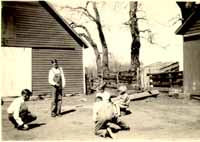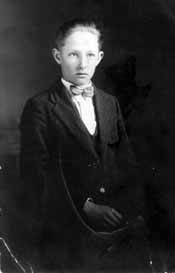|
Map of the Community
The Juhnke Family Farm
The Juhnke Farmstead
There had been a small one-story house on the farmstead when Ernest Juhnke bought it in
1914. By 1925 he sold the original house to Frank Eck in Elyria. On the old foundation
Ernest built a more adequate wood frame two-story house. The family used the porch and
doorway on the west side--rather than the door on the east side near the road. At the
center of the farmstead was a Woodmanse windmill, bought from Goering hardware in
Moundridge, which Willie could remember being built. Beside the windmill was a green
milkhouse-garage. Just west of the house was a shed, also painted green, which housed the
family's first car (an Empire), as well as the horse-drawn header-rack used for gathering
the hay. On the south side of this shed was a lean-to where young Willie stored his
collection of stick-horses. Nearby grew a small mulberry tree that was in Willie's way. He
chopped at it and trimmed it back. Later it grew into a very large mulberry tree which
produced large sweet mulberries. That garage-shed was torn down at about the same time the
milk-house/garage by the windmill was built.
On the west side of the farmstead were two buildings to shelter animals--pigs and
chickens. The chickens provided both eggs and meat for the table. Hog butchering day was a
celebrative event. Willie could expect uncles, aunts and cousins to come help with the
butchering and to enjoy some of the tastiest parts of the animal at mealtime--brains and
tenderloin. Another important source of food, of course was the garden, located south of
the house. Apparently, the Juhnke family did not depend extensively on irrigation for the
garden in dry years, because the windmill was located quite a distance from the garden.
There was a large cottonwood tree between the house and the road. It was part of a long
row of cottonwood trees which originally extended all the way a quarter mile north to the
Elyria road. These trees had been planted by an earlier owner of the property, perhaps by
one of the three women listed as earlier owners (Josephine Henry, Mary E. A. Smith,
Elizabeth Gamble.) Most of the cottonwood trees died or were destroyed, but the one by the
house thrived for a century and became one of Willie's favorites. Later in life, after he
had retired from teaching, he wrote a romantic imaginary story of the life of this tree
across the human generations it had seen come and go--"The Tree Speaks" (1981).
The tree of Bill Juhnke's imagination spoke, among other things, about Napoleon Kaufman
and his sons in 1900 arriving on a quest for land to buy. Upon seeing the rich land and
"level black soil" of the Dry Turkey flood pain for the first time, one of the
sons, Joe, a deaf-mute, spelled out in sign language, "THIS IS IT!"
Willie in his childhood had many aunts, uncles and cousins to visit. His mother was the
oldest of eight Kaufman children, all of whom married and had children. The Kaufman family
living closest to the Juhnkes, on the Elyria road about a mile east, was the family of
Leonard and Marie Schrag Kaufman. They had a son, Willard, two years older than Willie,
and a daughter, Pearl, the same age as Willie. Leonard Kaufman, known as "Uncle
Lee," had also been helped to get started in farming in King City township by his
father Napoleon. In 1915 Uncle Lee's farm was twice as large as Ernest Juhnke's.
There were nearby cousins on the Juhnke side of the family as well. Ernest was the
second of five living children (two siblings had died), all of whom married and lived on
farms in the Mennonite settlement. Ernest's sister Ida had married Simon Stucky, and they
lived on a 320-acre farm about two miles south and west of the Juhnkes. Simon had been a
school teacher and had an impressive library of fifty books. Ernest's brother Wesley had
married Amelia Graber, and they lived about the same distance in the opposite direction,
north and east. Their oldest son, Raymond, was two years younger than Willie. Uncle Otto
and Aunt Anna lived two miles west of Elyria. The families kept in close touch with each
other.
As a child Willie attended funerals of family members, reminding him that life on earth
was precarious. When he was nearly seven years old (1918) his grandfather, Carl Juhnke,
died at age seventy-seven. When Willie was eleven (1923), his cousin, Frieda Juhnke,
daughter of Uncle Otto and Aunt Anna, died at age fourteen. When he was thirteen (1925),
his cousin, Milford Stucky, son of Uncle Simon and Aunt Ida, died at age nine. When Willie
was seventeen, his sister, Anna, died at age twenty. Willie learned well that death was no
respecter of age.
Willie's grandfather, Carl Friedrich Wilhelm Juhnke, had a difficult life in his final
years. His second marriage, to Elisabeth Flickinger Zerger, had failed. He became involved
in a dispute with his son, Otto, over an issue of tying land inheritance to old age
support. (They took the dispute to the church for resolution.) Then his mind began to fail
and he would wander away from the farm house where he lived alone. When Willie was five or
six, he went along with his father who built a fence or wall around Grandpa's place to
keep him from escaping. But Grandpa defeated the attempt and managed to escape his
imprisonment. Finally, his children took the burden of taking turns to keep the
increasingly senile and sometimes irascible old man in their own homes. Grandpa taught
Willie some German-dialect sayings, no doubt learned in his childhood in Farther
Pomerania. One of these, as Willie later wrote it down, was: "In's Bet, in's Bet;
Wer eny het. Wer Keni het mus ok ins Bet!" ("To bed, to bed, who has one
yet; who has none yet, must also go to bed.") Once when Grandpa was staying at the
Ernest and Alvina Juhnke place, Grandpa and little Willie got into an altercation. Willie
threw a stick at Grandpa, who chased after him. Willie's mother came out of the milkhouse
and angrily scolded her father-in-law. Willie knew it was his fault and felt guilty about
it.
Grandpa Juhnke died on November 2, 1918, nine days before the end of World War I. As
Grandpa was on his deathbed, Willie's other grandfather, Elder Napoleon Kaufman, came for
a pastoral visit. Willie peeked through the door to the northwest room of the house and
saw both of his grandfathers at a moment of life's passage. Napoleon was kneeling at
Carl's bedside, holding the dying man's hand and bowing in prayer. After Carl died, Ernest
Juhnke put silver dollars over his eyes to keep them closed.
The most hair-raising event of Willie's childhood was a horse runaway in 1923, when he
was eleven years old. Ernest was responsible for maintaining township roads. He hitched up
three horses (named Fanny, Frank and Lincoln) to an old four-wheel buggy which had
belonged to Grandpa Carl.. Behind the buggy dragged a two section iron harrow to break up
the clods and fill in the ruts on the road. On this day Ernest and Willie drove southward
from the Juhnke farmstead, under the Missouri Pacific tracks and across Ghost Bridge over
the Running Turkey Creek, to the section corner where they turned right. When they came to
the Dry Turkey Creek bridge, Ernest got off the buggy to lift up the harrow so its teeth
would not catch a plank and tear it loose. Willie took the reins. Suddenly a frightened
rabbit jumped out from some brush in the ditch, and the three horses bolted--tearing the
harrow loose from the buggy and leaving Ernest behind.
Willie pulled on the reins as hard as he could and hollered for the horses to stop, but
they were running wild. They kept running west toward where the Valentine Krehbiel farm
was on the south side of the road. Willie saw that Krehbiel was out in the barnyard. As
his horses galloped past, Willie called out, "Schtop mei Keil!"--a
mixture of German and English. ("Stop my animals.") The horses kept running,
finally getting tired and slowing down to a trot. When they came to the next farmstead,
the place of Uncle Simon Stucky, Willie was able to turn them into the yard and direct
them toward the barn. There the horses finally stopped.
After composing himself, Willie decided to take the horses back to find his father. He
backed the horses away from the barn and tried to get them out toward the road. Instead,
the animals bolted out of control again, this time heading out toward the open field. Out
in the field was Uncle Simon working with his team of horses. Simon stepped in front of
Willie's runaways and got them under control. As they started back to the Uncle Simon's
farmyard, Willie saw Val Krehbiel's car with his worried father inside.
When they finally got home that noon, somewhat later than expected, Willie was
delighted to discover that his mother had fixed a meal of "mack plotzky,"
a Swiss-Volhynian dish of poppyseed sauce with dumplings and milk. The next Sunday Uncle
Ed and Aunt Kate Kaufman Goering came to visit. (Kate was Alvina's sister.) The big
runaway was the topic of conversation. Aunt Kate was impressed that Willie stayed with
horses rather than jumping off and possibly getting hurt. She said that her boys (Marvin
Goering was Willie's age) would have jumped off. That made Willie proud. |


